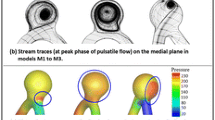Summary
The flow conditions and the related stresses in glass and silastic model aneurysms located at bifurcations were quantitatively determined by means of laser-Doppler-anemometry. The flow velocities in straight terminal models with the aneurysm forming an extension of the afferent vessel were unstable if the outflow through the branches of the bifurcation was balanced. Average flow velocities in the fundus were small, but irregular flow fluctuations of high amplitudes were observed. Asymmetrical outflow through the branches of the bifurcation induced a rotatory intra-aneurysmal circulation from the dominant to the subordinate branch. The circulation in angled terminal aneurysms with the aneurysmal axis at a 45° angle to the plane of the bifurcation was a vortex caused by the eccentric inflow from the afferent vessel. Maximum flow velocities measured in the center plane of the angled terminal aneurysms were in the range 50%–80% of the axial velocity in the afferent vessel. The present results indicate that the geometrical relation between aneurysm and parent vessels is the primary factor governing the intra-aneurysmal flow pattern. The elasticity of the models did not affect the average flow velocities, but the intra-aneurysmal pulse wave was damped in elastic models. On the basis of the measured velocity gradients near the walls, maximum shear stresses on the wall of a typical human terminal aneurysm were estimated to be in the order of 50 dyne/cm2 (5 Pascal), a value that is similar to the shear stresses that occur at the flow divider of a cerebral artery bifurcation. This is based on absolute flow velocity measurements in patients [8, 13].
Similar content being viewed by others
Reference
Ferguson GG, Roach MR (1972) Flow conditions at bifurcations as determined in glass models, with reference to the focal distribution of vascular lesions. In: Bergel VH, Derek H (eds) Cardiovascular fluid dynamics. Academic Press, London, pp 141–156
Giles RV (1962) In: Theory and problems of fluid mechanics and hydraulics. Schaums outline series. McGraw Hill, New York, pp 133–224
Hashimoto N, Handa H, Nagata I, Hazama F (1980) Experimentally induced cerebral aneurysms in rats, part V. Relation of hemodynamics in the circle of Willis to formation of aneurysms. Surg Neurol 13: 41–45
Kayembe KNT, Sasahara M, Hazama F (1984) Cerebral aneurysms and variations of the circle of Willis. Stroke 15:846–850
Kerber W, Heilman CB (1983) Flow in experimental berry aneurysms: method and model. AJNR 4: 374–377
Liepsch D, Moravec S (1984) Pulsatile flow of non-Newtonian fluid in distensible models of human arteries. Biorheology 21: 571–586
Liepsch DW (1986) Flow in tubes and arteries—a comparison. Biorheology 23: 395–433
Liepsch DW, Steiger HJ, Poll A, Reulen HJ (1987) Hemodynamic stress in lateral saccular aneurysms. Biorheology 24: 689–710
McMillan DE, Utterback NG, Nasrinasrabadi M, Lee MM (1986) An instrument to evaluate the time dependent flow properties of blood at moderate shear rates. Biorheology 23: 63–74
Stehbens WE (1963) Aneurysms and anatomical variation of cerebral arteries. Arch Pathol 75: 45–64
Stehbens WE (1975) Flow in glass models of arterial bifurcations and berry aneurysms at low Reynolds numbers. J Exp Physiol 60: 181–192
Steiger HJ, Liepsch D, Reulen HJ (1987) Basic flow structure in saccular aneurysms: a flow visualization study. Heart Vessels 3: 55–65
Steiger HJ, Reulen HJ (1986) Low frequency flow fluctuations in human saccular aneurysms. Acta Neurochir 83: 131–137
Suzuki J, Ohara H (1978) Clinicopathological study of cerebral aneurysms. J Neurosurg 48: 505–514
Tognetti F, Limoni P, Testa C (1983) Aneurysm growth and hemodynamic stress. Surg Neurol 20: 74–78
Author information
Authors and Affiliations
Rights and permissions
About this article
Cite this article
Steiger, H.J., Liepsch, D.W., Poll, A. et al. Hemodynamic stress in terminal saccular aneurysms: A laser-doppler study. Heart Vessels 4, 162–169 (1988). https://doi.org/10.1007/BF02058429
Received:
Revised:
Accepted:
Issue Date:
DOI: https://doi.org/10.1007/BF02058429



